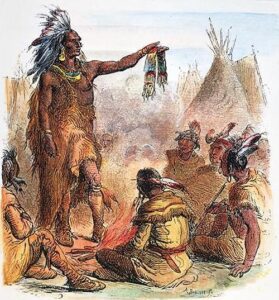
Reverend John Tecumseh Jones.
Reverend John Tecumseh Jones, commonly known as “Tauy” or “Ottawa” Jones, was a leading businessman and Baptist minister who served as an interpreter and leader for the Potawatomi tribe in Kansas. He also served as a leader for the Ottawa tribe and as their minister. He was a co-founder of Ottawa University in Ottawa, Kansas.
John Tecumseh Jones was born in southeastern Canada in 1808 to a Chippewa mother and an English father. He spent his early years with a sister and her blacksmith husband on Mackinac Island in Michigan. While living there, he befriended Captain Connor and rode on his ship to Detroit to live with Connor’s family, where he learned English and French. When Mrs. Connor died, Captain Connor threw Jones out of the family home.
Local Baptists took in Jones and, in the 1820s, recruited him and other local Indians to attend a Baptist mission school, Carey Mission, Indiana, for four or five years. He reacquired a knowledge of regional Indigenous languages in preparation for a mission to Native Americans. Next, he enrolled at Madison University in New York as a theology student.
Jones then taught at the Choctaw Academy boarding school in Kentucky for a year. After returning to Michigan to visit his sister, he visited Sault Ste. Marie, Michigan, where he worked as an interpreter.
In 1833, when the federal government moved the Ottawa Indians to their reservation in Franklin County, Kansas, Jones agreed to assist them in establishing their new home and act as interpreter for the Indians and government officials.
In 1838, Jones served as an interpreter for the Potawatomi tribe in Kansas. The following year, an Indian tribe known as the “Ottawa Indians” was transferred to the Ottawa area. Jotham Meeker, a missionary appointed by the Baptist Mission Board, was sent with this tribe. He brought the first printing press into Kansas. Reverend Meeker was determined to bring education and Christianity to these Indians.
In 1840, Jones married Rachel Littleman from the Stockbridge-Munsee Community. After she died in 1844, he married Jane Kelly, a missionary from Maine, in 1845. They purchased farmland approximately four miles northeast of Ottawa from a trader for $1,000.
At about that time, Jones was adopted into the Ottawa tribe and became one of the leaders, known as “Tauy” or “Ottaway,” which was an abbreviated version of “Ottawa.”
In 1848, Jones acquired a trading post on Tauy Creek from a trader named Roby. Jones built a log house and hotel on the site, which became a main stop between Fort Leavenworth and Fort Scott. Sympathetic to the abolitionist Free-State cause, Jones became a friend of John Brown and often assisted the Free Staters.
Though the couple tried to remain neutral in the slavery controversy, they were threatened by pro-slavery advocates. On August 29, 1856, pro-slavery Border Ruffians from Missouri burned down the Jones’ frame house in an attempt to kill Jones. He then built another house, and it was burned, too. Ten years later, the U.S. government appropriated $6,700 for Mr. Jones to compensate him for his loss.
At the first State Convention of Baptists meeting in 1860 at Atchison, Kansas, Jones suggested founding an integrated white and Indian school and securing 20,000 acres from the Department of Indian Affairs. This eventually became Ottawa University. However, no Ottawa Indian students ever attended Ottawa University on the college level because of their removal to Oklahoma.
In 1862, Jones hired Damon Higbie to build his third house, which is still standing. The massively constructed two-and-a-half-story, 14-room stone house was built in the Italianate style with Georgian details and a gable roof. It was built at a cost between $20,000 and $30,000. The house was built in a “T” shape, facing west. The walls were made of cut stone and were 34 inches thick. The stone was quarried near Fort Scott, Kansas, and transported by ox teams and wagons. It was constructed with wooden pegs and square nails, the woodwork was made of walnut, and two fireplaces were made of Indian marble. It is also said that at one time, the doorknobs of the house were made of sterling silver.

Tauy Jones Hall at Ottawa University, in Ottawa, Kansas.
There were unverified legends that the house was a stop on the Underground Railroad and that Abraham Lincoln slept there while traveling on a speaking tour. However, it is verified that Horace Greeley visited the Jones family. The house was added to the National Register of Historic Places in 1972.
Jones was actively involved with Ottawa University, serving on the Board of Trustees until he died in 1873. He was buried in the Indian cemetery northeast of Ottawa. In his will, his entire $25,000 estate, including 800 acres of land, was entrusted to Ottawa University. However, many claims were made against the estate, and the trustees were forced to settle them by disposing of the farm to raise money.
Today, Ottawa University’s oldest building, Tauy Jones Hall, is named after him. It houses various administrative offices, including the Chancellor’s Office, Human Resources Department, Finance Department, Marketing Department, and the Office of University Advancement. The copper dome on the top of the building is a distinct feature of this historic building. It was listed on the National Register of Historic Places in June 1982. It is on the Ottawa University campus at 1001 South Cedar Street in Ottawa, Kansas.
©Kathy Alexander/Legends of Kansas, updated January 2025.
Also See:
Sources:
Kansas Historic Resources Inventory
National Register of Historic Places
Wikipedia



